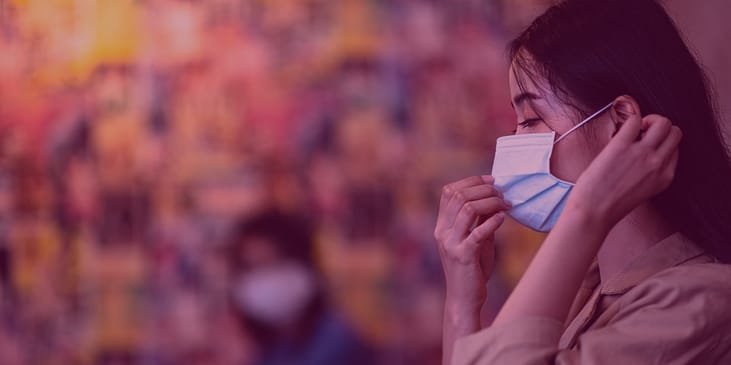by Kate Anderson
Some people have decided to “move on” from the pandemic, returning to offices and social events without masks. Many people believe that case numbers and hospitalizations have slowed down since COVID-19’s first two years, but case numbers, hospitalizations, and deaths continue to climb, with over 753 million confirmed cases and nearly 7 million deaths globally, numbers that epidemiologists say are undercounted by millions. As the virus continues to mutate and spread, Long COVID increasingly endangers and impacts the health of many people across the globe.
What is Long COVID?
Since 2020, millions of people have become disabled as a result of Long COVID, which has been described as one of the largest mass disabling events since the HIV/AIDS and polio epidemics. Up to a third of those infected with the COVID virus develop a persistent condition known as Long COVID, which is characterized by loss of taste and smell, respiratory and cognitive problems, and fatigue.
Of the millions impacted by Long COVID, some are able to continue working. However, many are forced to leave behind jobs and search for solutions from the medical community, which is slowly learning to respond to this new condition.
Researchers also estimate that about half of all people with Long COVID have developed ME/CFS, commonly known as chronic fatigue syndrome.
The Implications of a Mass Disabling Event
People with Long COVID who previously considered themselves healthy have struggled to find answers from medical professionals or to navigate the complex, hard-to-navigate disability benefits system. While reports indicate the majority of Long COVID patients are still in the workforce, many patients have had to reduce their hours, and it’s estimated that over half a million people have stopped working entirely due to their condition. The number is estimated to be considerably higher when it includes caregivers who’ve left the workforce.
While there are some resources to help people navigate the world of disability benefits, the influx of so many new disabled individuals has put pressure on the underfunded system and on the economy as a whole. With the sudden decrease of available workers, the labor market and economic security of the country’s workforce has been greatly impacted. Many articles cite “quiet quitting” or employee disengagement but fail to acknowledge the enormous toll of Long COVID in a worker’s decision and ability to continue at a job. A recent report by the New York State Insurance Fund highlighted the condition’s role in changing labor market statistics, stating plainly, “Long COVID has harmed the work force.” Disability advocate Imani Barbarin said, “Tragically, while the public saw disabled people as necessary losses in order to save the economy, they have been disabling themselves the entire time. They are us now.”
The British Medical Journal, or BMJ, recently published a study that states that most Long COVID symptoms improve within a year. The study used medical records from an Israeli health system, to track hundreds of thousands of children and adults who had been infected with COVID-19 without requiring hospitalization.
These results could be encouraging to some who are seeking a finish line to their symptoms. However, the study has many limitations.
“Improvement does not necessarily mean symptom resolution,” says Dr. Greg Vanichkachorn, an occupational medicine specialist who leads the Covid Activity Rehabilitation at the Mayo Clinic. “Some folks are still suffering serious symptoms two years or more out from their infection.”
The medical data used in the study follow records of Long COVID cases through October 2021, which therefore does not account for any Omicron or later variant cases.
An additional limitation of the study is the fact that it relies solely on medical records and does not include patient voices, since not all patient concerns show up in doctors’ notes. Dr. Ben Abramoff, director of the Post-Covid Assessment and Recovery Clinic at Penn Medicine, acknowledges, “We don’t really get a sense of how severe some of these symptoms are.”
Despite clear evidence of Long COVID’s impact, some doctors remain skeptical of the new condition, which would lead to further discrepancies between this study and more accurate timelines of recovery. Patient narratives are often dismissed by medical professionals, especially when patients are disabled or Black, Indigenous, or People of Color – and even more so when they are both.
Alexis Misko is a former occupational therapist who left her job due to Long COVID. Despite her background in the medical profession, she has found her perspective dismissed since becoming disabled.
“Once you become sick,” she told CNN, “Your expertise is erased in the minds of other people immediately.”
Employers, Individuals, and Businesses Can Provide Accommodations
Employers, individuals, and businesses can accommodate and support those with Long COVID in many ways, including the following:
- Provide reasonable workplace accommodations. Allow your employees to have remote work options whenever possible, take time off work when needed, and allow flexible deadlines to complete work.
- Offer livable wages and eliminate the subminimum wage. Fair pay helps employees pay for their medical expenses that are not in the scope of their health insurance plans, survive economically and removes the discriminatory practice of devaluing disabled workers.
- Expand health insurance options. Employers should offer health insurance options that ensure that those with Long COVID can have their doctor visits covered by their health insurance plans.
- Require masks in inside or crowded places. People who have already had a COVID infection become more likely to be re-infected with each infection, and once re-infected are drastically more likely to die or need hospitalization. Requiring masks will reduce the risk of infection for everyone, and protect people with Long COVID from repeat infections.
- Invest in high quality air filtration in your shared spaces, and advocate for policy and initiatives that fund and support structural changes to make air filtration possible and affordable on a larger scale, such as in schools, public transportation, and other gathering places in your community. Like widespread use of masks, air filtration is shown to remove COVID-19 from the air, and can do the same for other airborne viruses.
- Advocate for extended State of Emergency declarations, which have provided important access to resources including healthcare coverage and costs for COVID testing, treatments, and vaccines, telehealth availability, and more.
Future Outlook
As more people develop Long COVID, the condition will continue to affect not just individuals and families, but entire populations, communities, disability benefits systems, and the global economy. Greater knowledge and awareness can potentially help not only those with this post-viral condition, but individuals who have been disabled for years, as well. It is incumbent upon society as a whole to provide accommodations for those who are affected by Long COVID and disabled people at large. Moreover, the pandemic continues to be an opportunity for everyone to prioritize Disability Justice, which requires us to make the kind of changes that we will need as we evolve to face an emerging era of pandemics.

Kate Anderson is a Freelance Writer for WID.
Long COVID Advocacy Social Media Pages:


0 comments on “The Effects of Long COVID”